CarEdge saved me over 4,500 dollars on a brand new Honda Pilot. I can't say thank you enough.
Price intelligence
Find a wide range of vehicle listings with market insights on new and used listings near you.


Help us personalize your CarEdge experience — it only takes a second.
Your answers help us personalize your CarEdge journey — we’ll follow up with tips and next steps that match your buying timeline.


The manufacturing of electric vehicles is a global process, with raw materials from every corner of the globe playing a vital role in battery chemistry. New forecasts from automotive energy analysts predict massive increases in electric vehicle production costs due to the entanglement of EV supply chains in the ongoing Russian invasion of Ukraine. The latest supply chain worries are on top of the ongoing chip shortage that threatens to stretch through 2022.
In 2021, fully-electric and plug-in hybrid passenger vehicles soared to 9% of global new vehicle market share. In Europe, EVs now make up 19% of all passenger vehicle sales. Even in the United States, electric car market share is approaching 5%. Although EV sales continue to be subdued by supply shortages and lack of inventory, most automakers remain on a path towards 100% electrified sales. However, getting there is easier said than done without the raw materials needed to make gigawatt-hours of batteries. There are dozens of EVs on sale in 2022, but finding one on a dealer lot is no easy task.
A new report by S&P Global Mobility highlights the unforeseen costs piling onto EV battery production because of the Russian invasion of Ukraine, and the resulting international sanctions. Building an electric car is about to get costlier, and buying one will get more expensive.
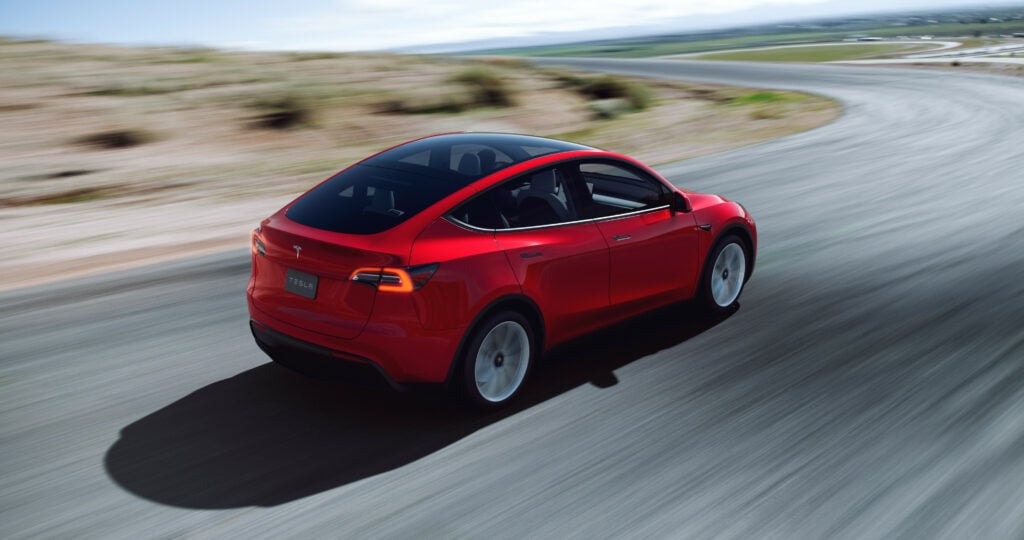
The analysts at S&P Global Mobility estimate that the best-selling Tesla Model Y could see input costs for battery raw materials surge by $8,000 per vehicle this year. Tesla recently increased Model Y prices for the tenth time in as many months to a base price of $62,990. Just a year ago, the same model listed for $49,990.
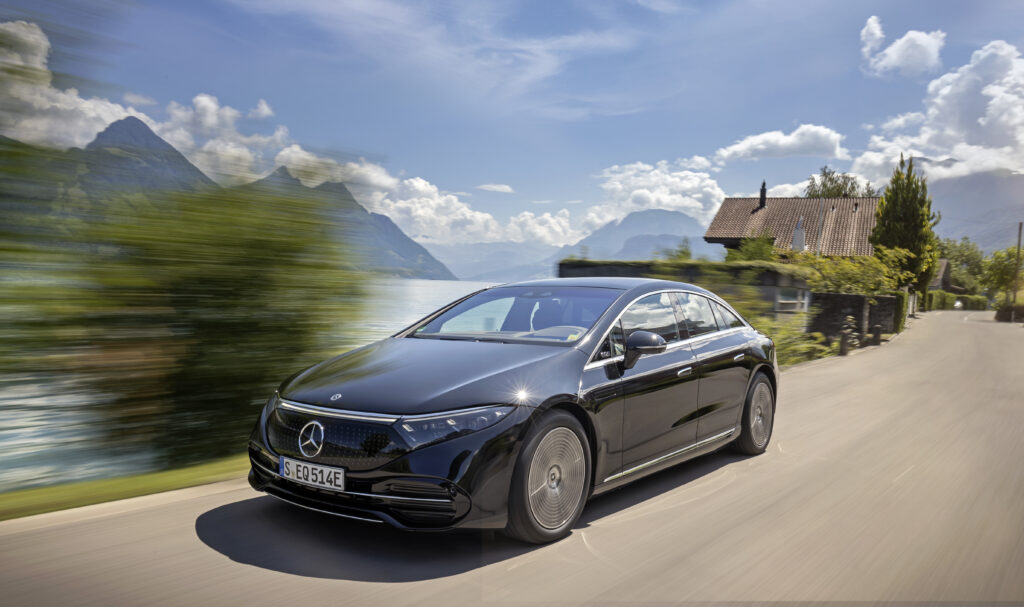
The same report forecasts that production costs for the popular Mercedes-Benz EQS could skyrocket by $11,000 year-over-year. The EQS luxury sedan already starts at an MSRP of $103,360, and climbs to $126,360 for the highest trim. With production costs eating into Mercedes’ margins, MSRPs are likely to climb higher any day now.
For years, EV advocates (and Elon Musk) have touted the importance of electric cars reaching cost parity with combustion-powered vehicles. It’s widely believed that when electric cars cost the same as an equivalent ICE car, the masses will rapidly transition to electric mobility.
The latest supply chain disruptions have analysts delaying the arrival of EV cost parity. In the months leading up to the war in Ukraine, raw materials needed for battery production were already becoming more costly. Cleantechnica reported back in November that lithium carbonate prices surged by 313%, cobalt hydroxide was up nearly 82%, and nickel sulfate rose by 34% over the course of 2021.
S&P Global Mobility said that Russia’s invasion of Ukraine is inflating raw material prices even further. Russia is the world’s third-largest supplier of nickel. German supplier BASF said it will not sign new agreements with Russian nickel suppliers because of the invasion. The analysts suspect that other manufacturers will take similar actions.
The latest data and expert analyses point towards a 5-10% increase in prices for most EV models in 2022. Tesla has already seen a 26% increase in prices since 2022, including steep price hikes in early 2022.
There are rumors that Hyundai may soon be raising MSRPs for the popular IONIQ 5, and Ford increased prices for the Mustang Mach-E by $1,000-$3,000 in February. When is the most affordable time to buy an electric car? If you’re set on buying an EV in 2022, make a purchase as soon as possible. Unfortunately, it looks like inventory and pricing are only going to get worse for the foreseeable future.
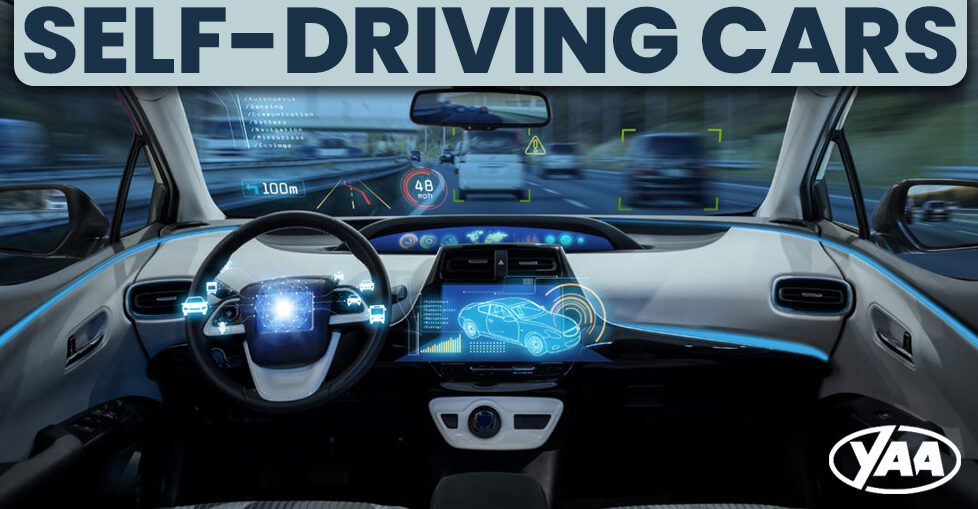

On March 10, 2022, the United States National Highway Traffic Safety Administration (NHTSA) announced safety standards for vehicles without human controls. The historic announcement effectively eliminates the requirement for human controls in future vehicles designed to be fully autonomous. In a few year’s time, cars without steering wheels may enter production.
“As the driver changes from a person to a machine in vehicles equipped with automated driving systems, the need to keep the humans safe remains the same and must be integrated from the beginning,” said Dr. Steven Cliff, NHTSA’s Deputy Administrator. “With this rule, we ensure that manufacturers put safety first.”
Before the NHTSA rule update, occupant protection standards were written for common, traditional vehicles. You know, the ones with steering wheels. The rule updates the standards to clarify what is required of manufacturers when applying the standards to vehicles without traditional manual controls.
In essence, the rule change permits vehicles to operate without driver controls, as long as automakers continue to provide the same high levels of occupant protection as current passenger vehicles.
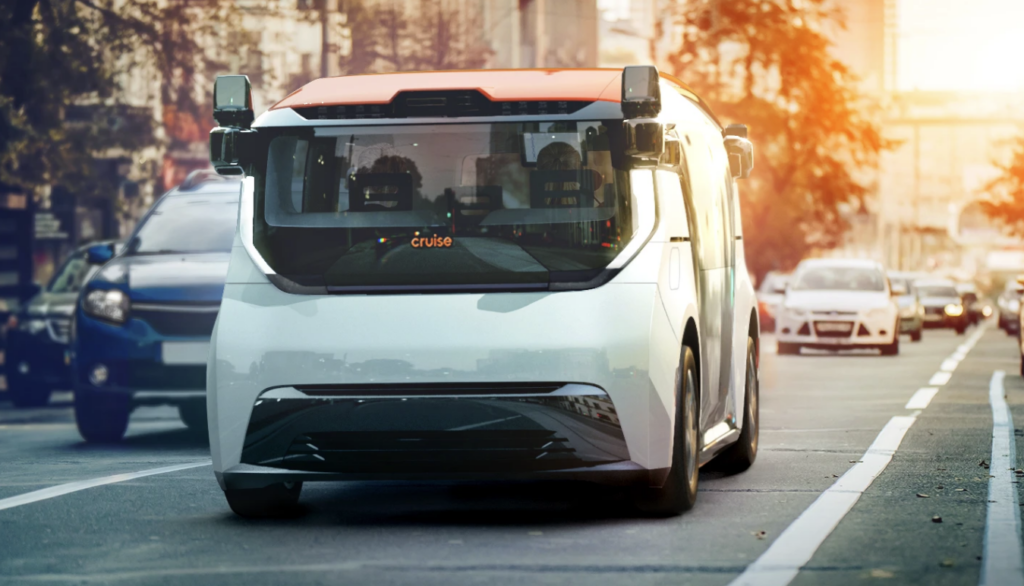
The NHTSA’s rule change comes in response to a petition from General Motors’ Cruise division to update the requirements for future self-driving vehicles. The new regulations eliminate the need for manual driving controls (a steering wheel and pedals) in fully-autonomous vehicles. This particular rule pertains to crash safety standards. No steering wheel, no problem.
In February, GM’s petition sought to make the case for NHTSA action.
“This petition both demonstrates how the Origin achieves safety objectives of existing standards, and helps enable future AV regulations. NHTSA has made clear in public testimony and regulatory actions, that in order to consider the development of AV standards, they first need more information from real world AV operations. We believe this petition can help enable that outcome: learnings from the Origin, which is designed to improve overall road safety, can help inform the creation of new, updated regulations and standards.”
GM’s Cruise recently unveiled the Cruise Origin, a purpose-built autonomous pod designed for urban mobility. The Cruise Origin and other autonomous vehicles in development needed the NHTSA to update the rules before embarking on the final stages of development. In fact, most automakers are working on autonomous driving technologies.
At least one automaker has refrained from bringing its level 3 autonomy to the United States because of outdated regulations. In 2021, Mercedes-Benz became the first automaker to get regulatory approval for level 3 autonomous driving on European public roads. For now, Mercedes Drive Pilot is available on 8,197 miles of German highways at speeds up to 37 miles per hour. What makes Mercedes Drive Pilot so special is that it is the first approved consumer-ready system to permit the driver to take their attention away from the road while the vehicle is in motion.
Mercedes-Benz cited the murky regulatory environment in America as reason for the delayed rollout of Mercedes Drive Pilot in the US. Now, Mercedes says it intends to bring level 3 Drive Pilot to American roads later in 2022. The S-Class and all-electric Mercedes EQS are the first models to gain Mercedes Drive Pilot in the US.
BMW also hopes to launch Level 3 features on the 7 Series sedan this year.
See every automaker’s plan for autonomous driving here.
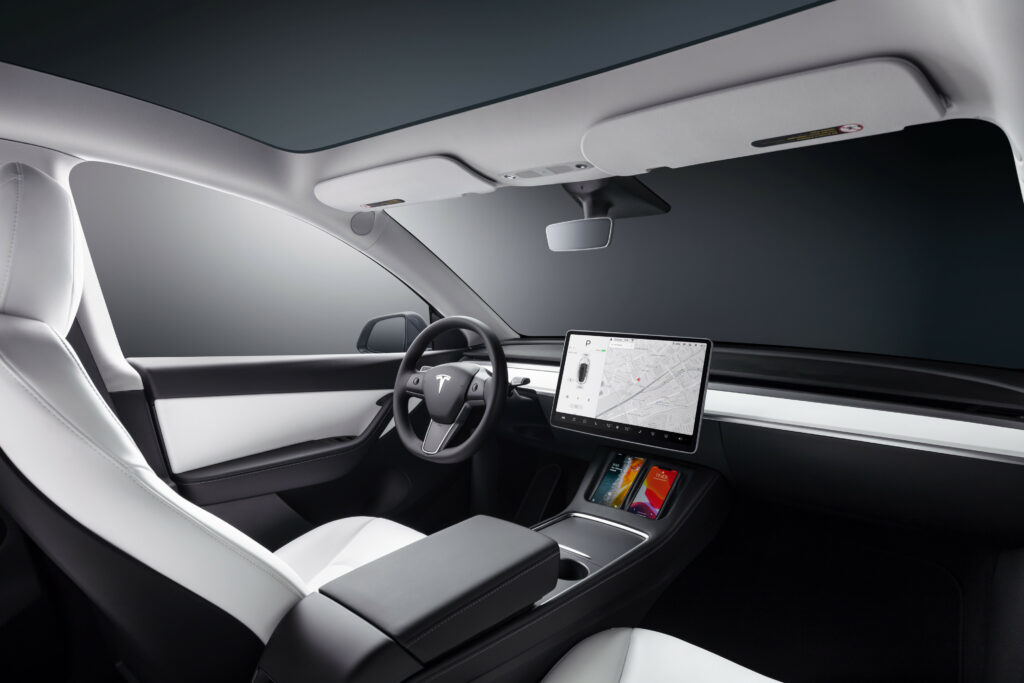
Elon Musk was an early proponent of building cars without driver controls. The updated US regulations will open the pathway for Tesla’s without steering wheels. However engineering autonomy has proven to be a greater challenge than anticipated.
Tesla CEO Elon Musk reflected on the complexity of autonomous driving in a recent interview. “I thought the self-driving problem would be hard, but it’s harder than I thought. I thought it would be very hard, but it was even harder than that.”
That isn’t to say that Tesla is giving up. Tesla remains a leader in automation. The controversially-named ‘Full Self-Driving’ feature is currently available to beta testers with high safety scores. However, criticism abounds from customers who are upset over years of delays for a feature they paid $6,000 to $12,000 for.
Tesla’s vertical integration is one of its greatest strengths. Tesla controls the hardware and software in its cars that will one day support autonomous driving. Little by little, they are making steps in that direction. In 2021, Tesla even eliminated the gear selector in the refreshed Tesla Model S. Apparently, the car should ‘know’ which direction it needs to go. Tesla’s engineers think that today’s Teslas are capable of figuring that out. There are gear selector controls on the touch screen in case the car guesses wrong.
Still, the 2022 update to NHTSA regulations paves the way for Tesla, GM, Mercedes and other automakers to make their autonomous dreams a reality. If only they can figure out how to get it to work. I don’t expect to see a single production car without a steering wheel until closer to 2030. Commercial ride-sharing ventures like GM’s Cruise could, however, bring vehicles without driver controls to American roads within a few years.
Here Is Every Automaker’s Plan for Autonomous Vehicles
What would it take for you to feel safe buying a vehicle without a steering wheel? Wouldn’t that take the fun out of driving? Perhaps folks like me will be in search of aftermarket steering wheel mods in a decade’s time.

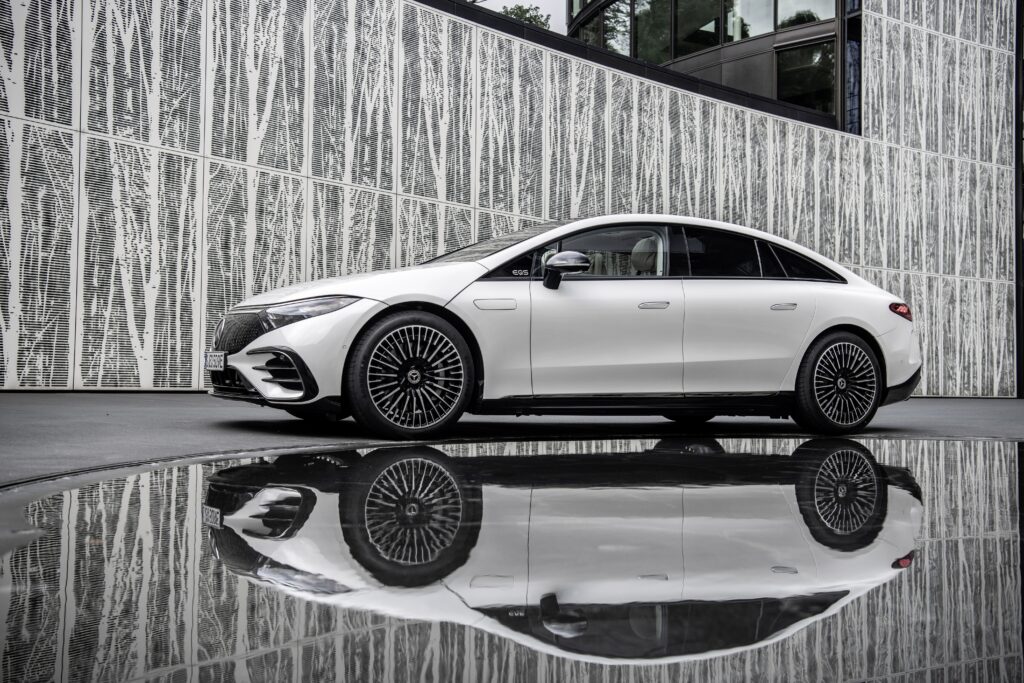
Tesla can’t be the best at everything. The world’s leading electric vehicle manufacturer arguably has the best technology integration, an impressive global charging network, and some of the best range out there. However, Tesla’s luxury competitors seem to have found its weaknesses.
It’s hard not to compare every electric vehicle to Tesla. Considering their lead in the EV segment, it would be irresponsible not to. The 2022 Mercedes EQS is an example of what’s possible when legacy automakers take EVs seriously. Is it a real contender that big wallets should consider? If the EQS is a sign of things to come from Mercedes, luxury aficionados have a lot to look forward to.
Beauty is in the eye of the beholder, right? The 2022 Mercedes-Benz EQS is not the prettiest luxury sedan. In fact, many think it’s outright ugly. CarEdge’s Zach Sheska says the EQS looks like a dolphin, and nothing will change his mind. Here’s the thing: it looks like a dolphin for a reason!
What are dolphins good at? Maneuvering through the water effortlessly. The Mercedes EQS’ blunt-nosed looks are the product of German engineers’ efforts to streamline the shape of the vehicle. No matter what you think about the looks, it worked. The EQS has the lowest drag coefficient of any production vehicle in history at just 0.20. The EQS slices through the air with less resistance than any other car you can buy. The results? A silent ride and excellent range.
The question remains, will luxury buyers fork over $100,000 for a Mercedes that looks like this?

Other than the overall shape, nothing about the EQS’ exterior is particularly eye-catching. It’s a long car, at just over 207 inches. The length adds to the teardrop look of the car (it’s all about efficiency!) Yet, it doesn’t quite look like any other Mercedes-Benz. Subtle light bars in both the front and rear accent the EQS with a touch of modernity that most Mercedes models dare not approach.
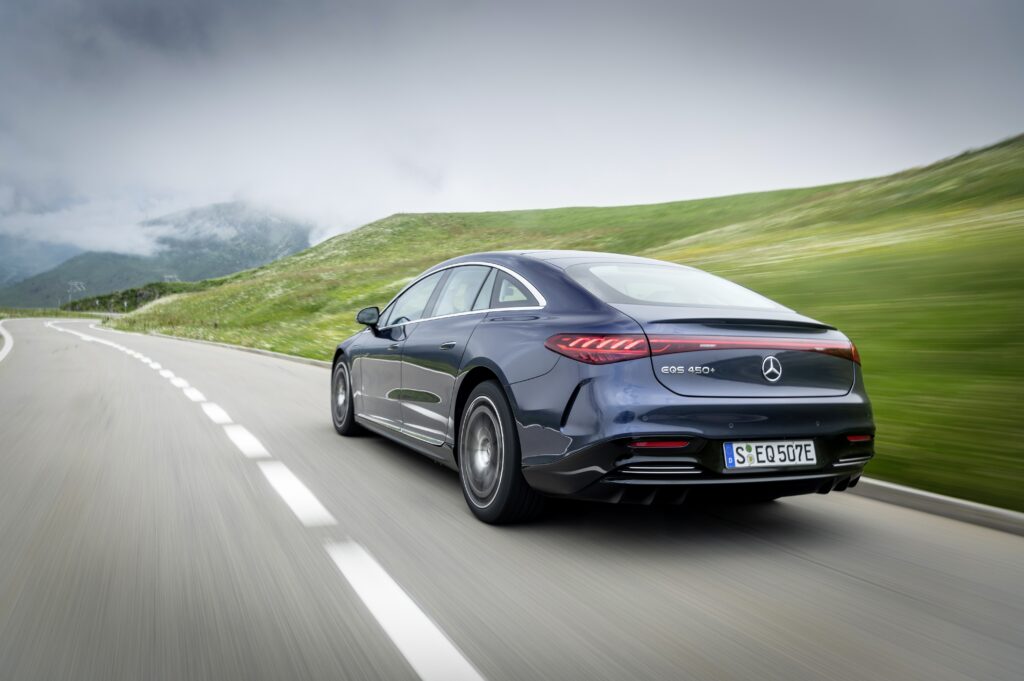
Just about the only thing the EQS has in common with the revered S-class is the general price range over $100,000. Buyers who tend to go for tradition rather than innovation will likely choose the latter. The differences don’t end on the exterior.
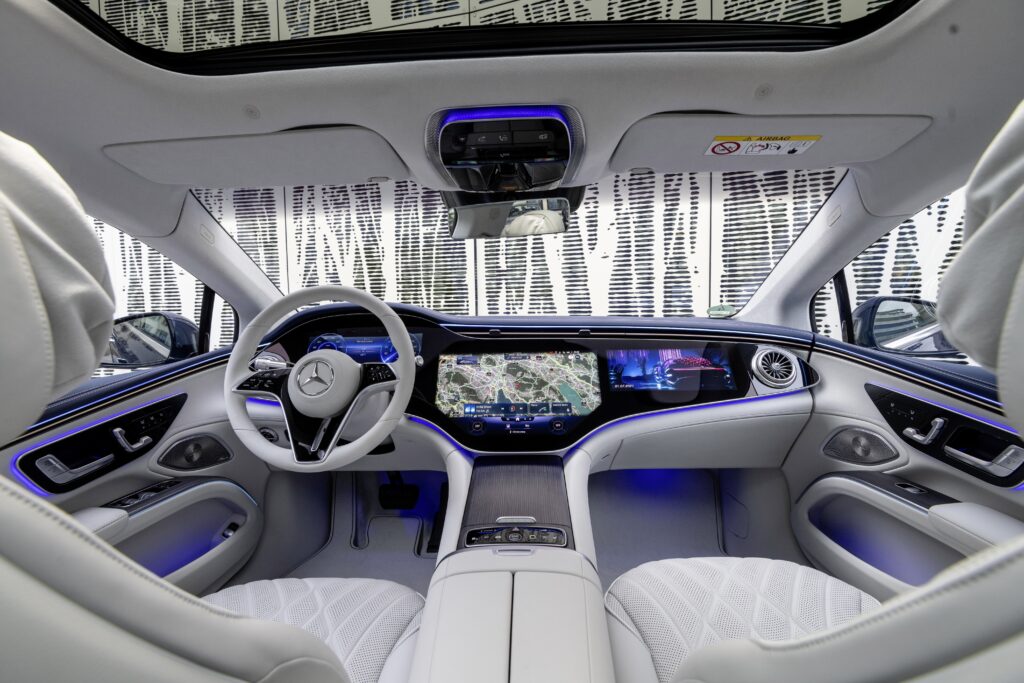
Mercedes-Benz says it tasked their engineers and interior designers with the mission of rethinking what’s possible in a luxury interior. They wanted a completely new approach, unlike anything that had been seen before. Today, Mercedes considers the result a unique pairing of avant-garde and tradition. It’s where tranquility and interactivity come together. Is it enough to make up for how it looks on the outside?
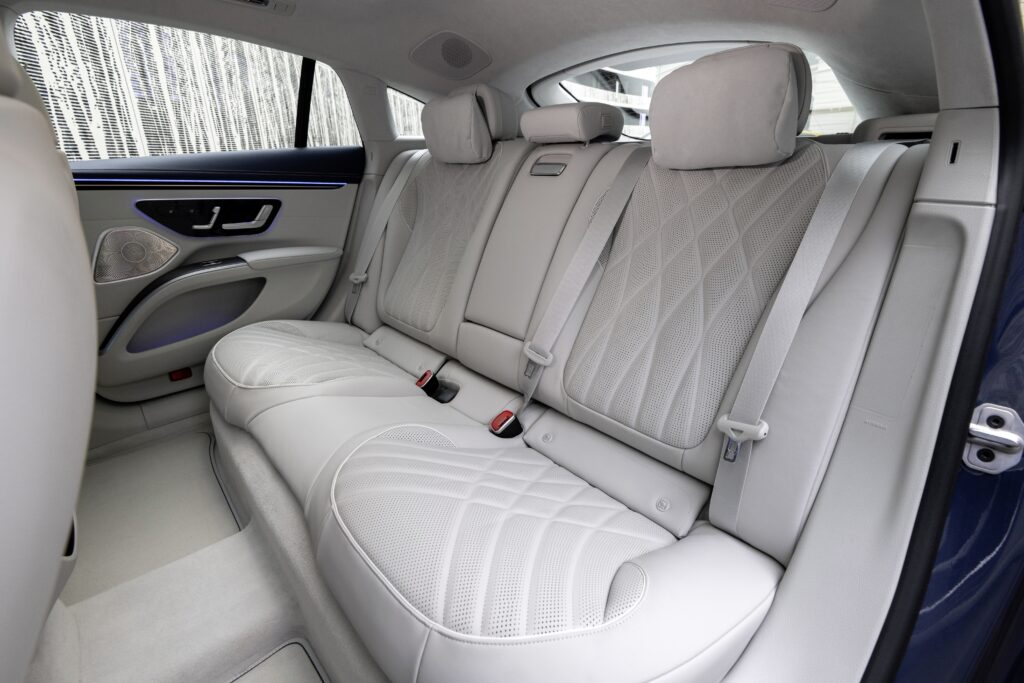
Mercedes has not announced the official cabin volume, but we can see from the generous headroom (40.4 inches) and legroom (41.7 inches) that the EQS is a large sedan.
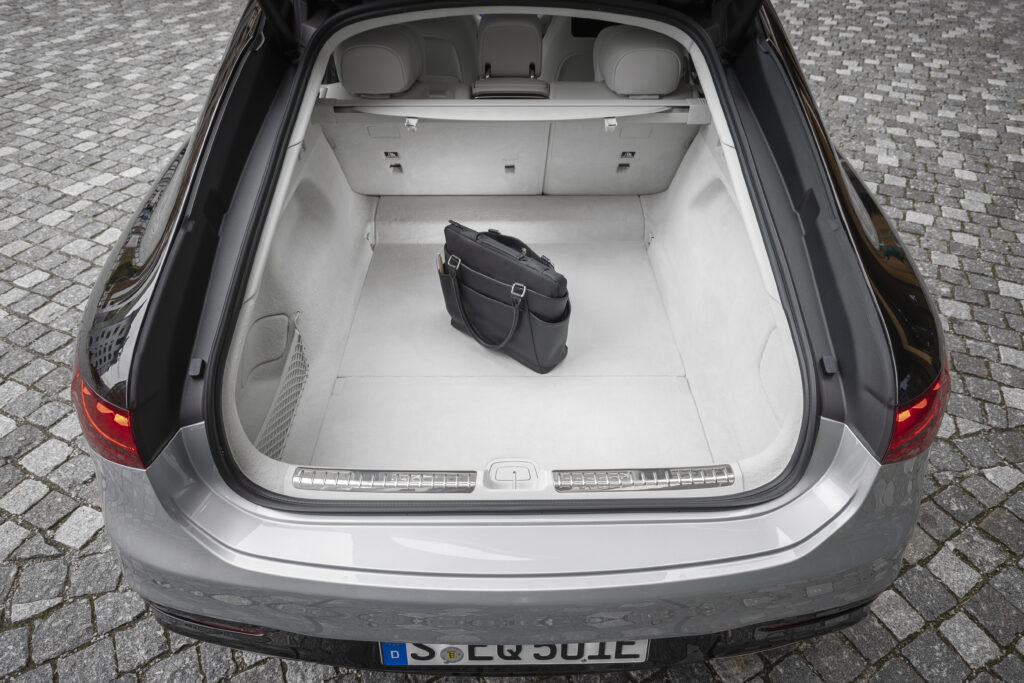
The EQS has 22 cubic feet of cargo space behind the rear seats, accessible via a hatchback-like trunk. With the seats folded down, this sedan-turned-hatchback opens up to 63 cubic feet of cargo space.
Stepping into the EQS, eyes are immediately drawn to the 56 inch Hyperscreen that wraps from the gauge cluster all the way to the passenger door. The EQS Hyperscreen is essentially three screens built into one seamless panel. There’s a digital gauge cluster, a vertical center screen for navigation, comfort controls, and entertainment and something Tesla certainly doesn’t have: a passenger screen. The EQS passenger screen is such a game-changer that I suspect Tesla will bring a passenger screen to the Model S and Model X in response.
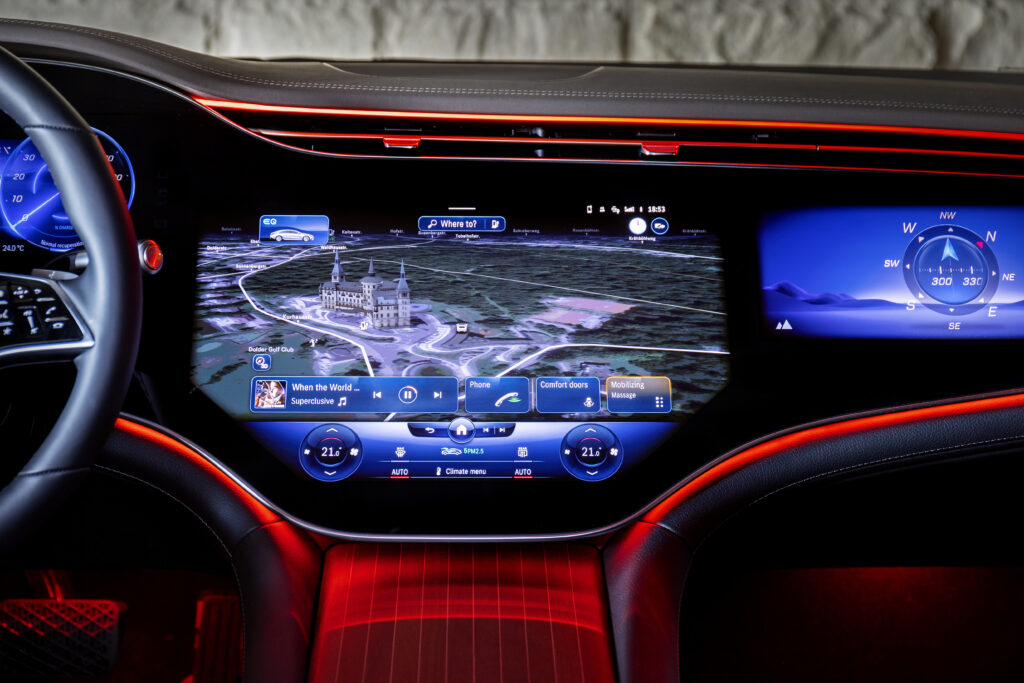
Passengers in the EQS have the freedom to do almost everything that the driver can do. Using the EQS passenger screen, you can make phone calls, adjust seating comfort, climate control settings, access endless entertainment and even vehicle navigation. In the EQS, the front passenger can be a real co-pilot!
Speaking of aviation, the EQS has an excellent heads up display. It’s more functional than the ones you’ll find in most vehicles. In the EQS, the heads-up display does not only indicate speed and highway signage. Arrows guide the driver through navigation in real time, and Level 2 driver assistance visualizes following distance with radar-like precision.
Ambient lighting accents are well placed throughout the front and rear cabin. Mercedes has given the EQS customizable ‘sound experiences’ to replace the traditional rumble of combustion. In the center console is a fingerprint reader. This device recognizes who is in the car and adjusts seating position and other features accordingly.
If you’re a fan of Tesla’s ‘Easter eggs’, you’ll be happy to learn that Mercedes includes what they call ‘graphical goodies’ in the EQS. Holiday and seasonal themes adorn the infotainment with quirky little nuances that add character to the silence of the EV.
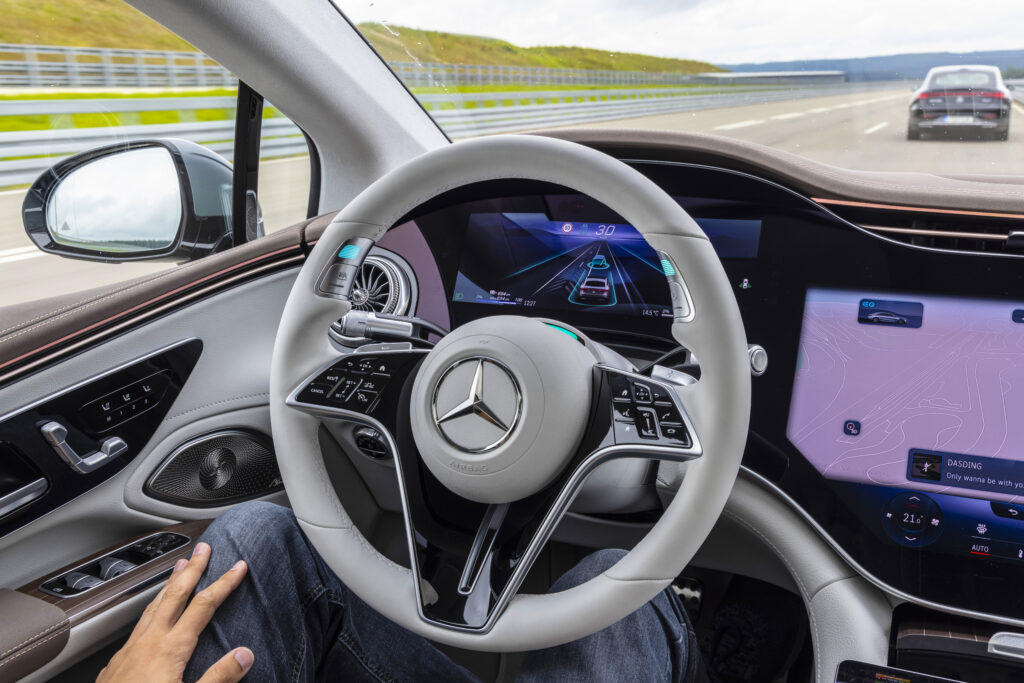
The MBUX infotainment technology shines as a responsive and user-friendly navigation system and access point for vehicle controls and entertainment. A 360-degree camera system provides assistance with parking, and doubles as your security monitor. Yup, just like Tesla Sentry Mode.
The Mercedes EQS is data-heavy. Accessible via the center screen is real-time power distribution data that shows exactly how much electricity is being consumed by each part of the vehicle. Sure, it’s basically the same display we see in the $45,000 Hyundai IONIQ 5, but it’s still great to have.
Mercedes is pioneering Level 2 and Level 3 advanced driver assistance on a path to eventual autonomy. On select German roads, the EQS can maneuver in traffic at speeds up to 38 mph. Eventually, Mercedes’ Level 3 driver assistance may be available in North America.
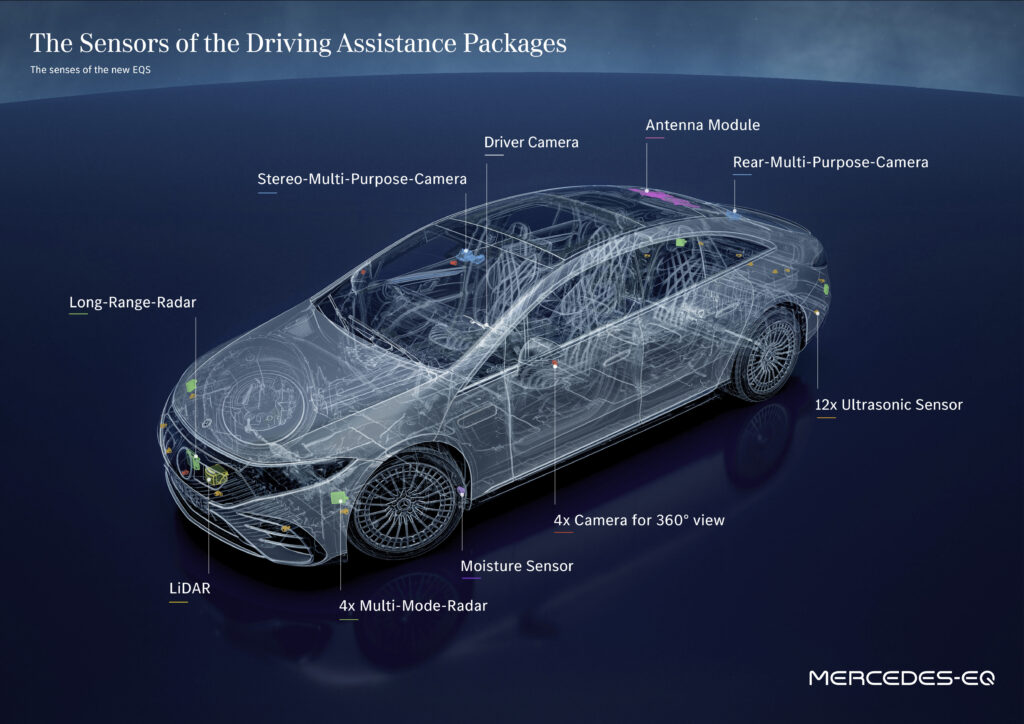
The entry-level Mercedes EQS 450+ starts at $103,360. It’s properly-equipped for the price point, but lacks the Hyperscreen found in higher trims. The EQS 450+ tops out at $109,560 for the Pinnacle trim. The EQS 580 Premium picks up at $120,105, adding another motor, 187 more horsepower and a step up in luxury. A top-of-the-line EQS 580 Pinnacle costs $126,360, but a fully-loaded car goes even higher.
Here are the trim and pricing details for the 2022 Mercedes EQS:

According to the United States EPA, the 2022 Mercedes EQS 450+ is rated for 350 miles of range. Edmunds found that the EQS can make it 422 miles on their test track, making it the new all time range l in their testing. Although the Tesla Model S Long Range is rated for just over four hundred miles, real world mileage tends to be a tad lower. Only the brand-new 2022 Lucid Air has a longer range.
Powering the EQS is a 107.8 kWh lithium-ion battery pack supplied by CATL. Mercedes advertises up to 200 kW charge rates at DC fast chargers. Early tests show that the charging curve is pretty good, making it possible to charge from 10 to 80% in just 28 minutes. A deep-dive analysis by InsideEVs found that the average charge rate during a session is 155 kW, which is exceptional.
Over 80% of charging is done at home, and the EQS is behind the competition in this regard. Add a level to 240-volt charger at home, the eqs can only accept up to 9.6 KW. That means it will take around 11 hours to fill the battery from an empty charge. Keep in mind that charging is typically done overnight while you sleep and the battery is rarely drained to 0%, so this is not likely to be a problem for most drivers. You always have the option of plugging in at a public DC fast charger if you’re in a hurry.
The EQS 450+ features a rear-wheel drive electric motor that generates 329 horsepower and 406 lb-feet of torque. Stepping up to the EQS 580 4Matic, the car gets an electric motor on each axle, and a lot more power. The EQS 580 has a total output of 516 HP and 611 lb-feet of torque. The car weighs nearly 6,000 pounds, so the power isn’t as jaw-dropping as it sounds.
Mercedes estimates the rear-drive variant will accelerate from zero to 60 mph in 5.5 seconds. The dual-motor EQS 580 4Matic drops the zero-to-60-mph time to 4.1 seconds. A Tesla Model S is two seconds quicker, but do you really need that much power?
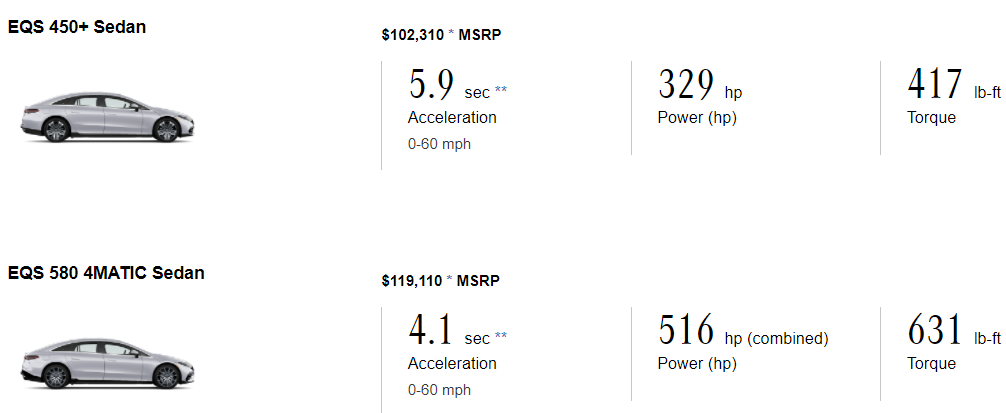
Handling is more forgiving with a softer ride than you’ll find in a Tesla. To most Mercedes buyers, that’s a good thing. The firm ride is not desirable to most Mercedes customers. The EQS is a car built for cruising, not for the track. An adaptive air suspension ensures that passengers are in for a silent and smooth ride.
The buying process is pretty simple for the 2022 Mercedes-Benz EQS, if you can find one. Mercedes lets you build and configure the EQS on their website, but if you’re looking to buy, you will have to go through a Mercedes dealership. The automaker advises potential buyers that the ongoing chip shortage is limiting various supplies and impacting pricing. Make sure you are prepared with car buying know-how before you walk into a dealership.
A few used Mercedes EQS’ are already available in some parts of the country. Don’t forget that you can check out new and used vehicle listings as well as auto industry insights at the CarEdge Car Search. It’s more than your average vehicle listing service. CarEdge Car Search was made to give the consumer the upper hand when buying a vehicle.
Unfortunately, you don’t always get what you pay for. True value is hit-or-miss in today’s automotive market, whether you’re looking for a budget vehicle or a luxury sedan. Even Tesla’s are sometimes delivered with shocking quality control faults. The 2022 Mercedes-Benz EQS does have a luxury price tag, but buyers of this spaceship-like electric vehicle are getting their money’s worth and then some.
On the other hand, Mercedes and the other German luxury brands are late to the EV game. Tesla sold nearly 1 million Vehicles last year, and they’re opening two additional factories in 2022. Will the Mercedes EQS be a force to be reckoned with? Or will it sell in limited volume as Tesla continues to dominate? We’d love to hear from luxury vehicle customers. What’s your take on what Mercedes-Benz is offering with the 2022 EQS luxury electric vehicle?

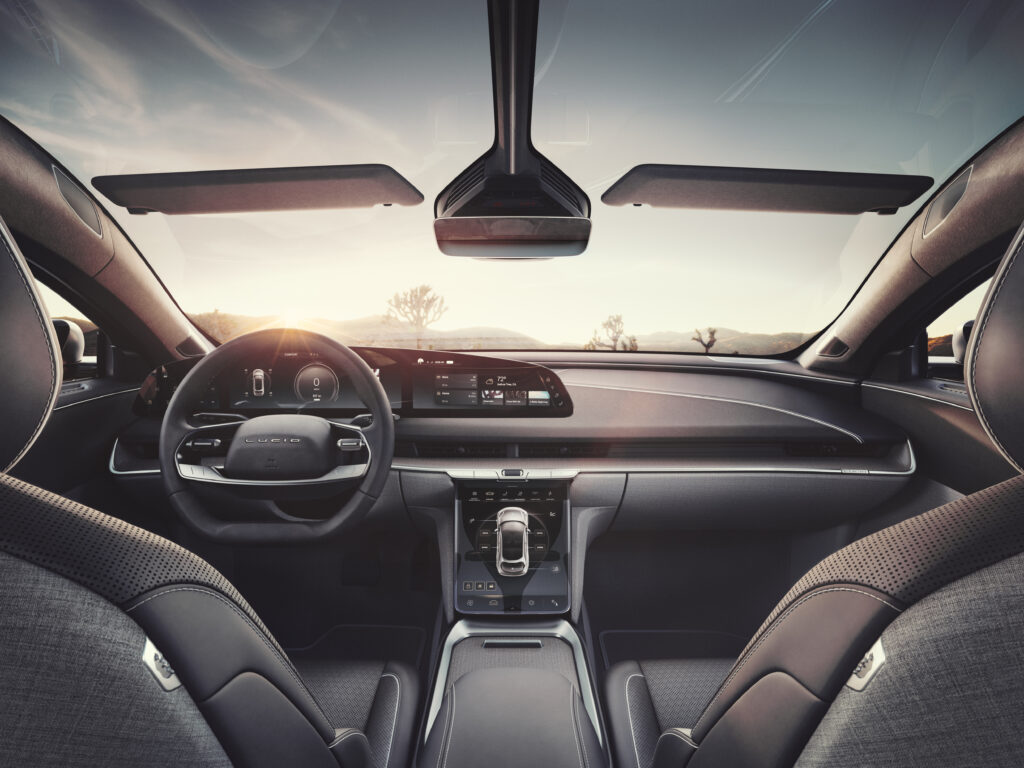
What does 2022 have in common with the 1939 World’s Fair? It’s the feeling that autonomous vehicles are right around the corner. Nearly every automaker, from Tesla to Ford, has overpromised and underdelivered on their plans for autonomous driving. Tesla CEO Elon Musk said it himself recently in an interview with researcher Lex Fridman. “I thought the self-driving problem would be hard, but it’s harder than I thought. I thought it would be very hard, but it was even harder than that,” Musk reflected. He’s not the only one to misjudge the enormity of the task at hand. You’d think automakers would stop giving themselves deadlines that are destined for letdowns.
It turns out that there’s been one overarching theme in the learnings from the past decade of development. Engineers now see that in order for self-driving cars to be safe and successful, cars will have to learn to think like a human. Computers are exceedingly good at performing repetitive tasks. What they’re not great at is responding to unique situations full of unknowns. The human brain is more capable than some give it credit for. We’re very good at dealing with unknowns and making complex decisions on the fly.
After reading this article, you’ll better understand what self driving cars are, the difference between self-driving cars and autonomous vehicles, and the terms and jargon associated with self-driving cars. Let’s dive in.

As you’re soon about to learn, the world of autonomous cars and self-driving technology is full of terms worth defining. For starters, what is self-driving in the world of transportation? Self-driving cars can drive in some or even all situations without driver input, but a human must always be ready to take control. Think of them as a crucial stepping stone on the path to full autonomy.
Self-driving cars are not fully autonomous. In the world of professional engineering, ‘automation’ is the preferred term for the sliding scale of vehicle operation status. In fact, the United States National Highway Traffic Safety Administration (NHTSA) refrains from using the term “self-driving” at all, and most engineers disagree with the use of the term. Let’s dive into the terms and definitions that relate to so-called self-driving cars, and the future of automation as a whole.
First, let’s clear the confusion. Talking about automated cars warrants a glossary of its own. Being well-informed is the key to knowledge, and we all know knowledge is power. Here’s a list of the terminology you’re likely to encounter in a self-driving world. In most cases, the difference is in the finest of details.
These are technological features designed to improve driving safety. These software-based systems improve a driver’s ability to react to adverse situations on the road. Examples include adaptive cruise control, forward collision warning and lane departure warning. ADAS features are very common in newer car models.
This term is thrown around a lot, but a true autonomous vehicle is capable of sensing its environment and operating without human involvement. Human passengers can take their eyes off the road and just enjoy the ride. Imagine entering the destination address, and that’s it. Autonomous vehicles can do everything that an attentive human driver can do.
Usually referring to Tesla Autopilot, which is a suite of ADAS features that enable the vehicle to steer within a lane and adjust speed in response to surrounding traffic. It’s essentially adaptive cruise control plus lane centering. Autopilot is standard on all new Tesla models.
Tesla “Full Self-Driving” in its current iteration is not much different from driver assistance technologies. Tesla enthusiasts, relax. That’s likely to change as Tesla updates the software regularly via over-the-air updates that simply require WiFi to install. Automotive engineers generally refrain from using this term altogether, as it’s more associated with marketing than with engineering automation. A true full self-driving car can navigate roads with human supervision. Tesla’s program is getting close, but as thousands of videos online will show you, Tesla FSD is not quite there yet. It is impressive though. Tesla FSD can be yours (someday) for an additional $12,000 when you buy a new Tesla vehicle.
This is when a vehicle’s operation is limited to a restricted geographic area. For example, Waymo’s driverless vehicles are geofenced to only operate in the Phoenix metropolitan area. Geofenced autonomous vehicles will grow in popularity before true, independent autonomous vehicles put rubber on public roads.
Light Detection and Ranging. LiDAR is the go-to ‘radar’ technology for nearly all self-driving innovators. Except of course for Tesla, who seems to think image processing with cameras is the way to go. LiDAR can ‘see’ through low visibility conditions, including fog and heavy rain.
When a vehicle can perform most driving tasks in a geofenced area, but with constant human monitoring and intervention when needed, some in the automotive industry consider it to be self-driving. The degree of human input varies. More on that below…
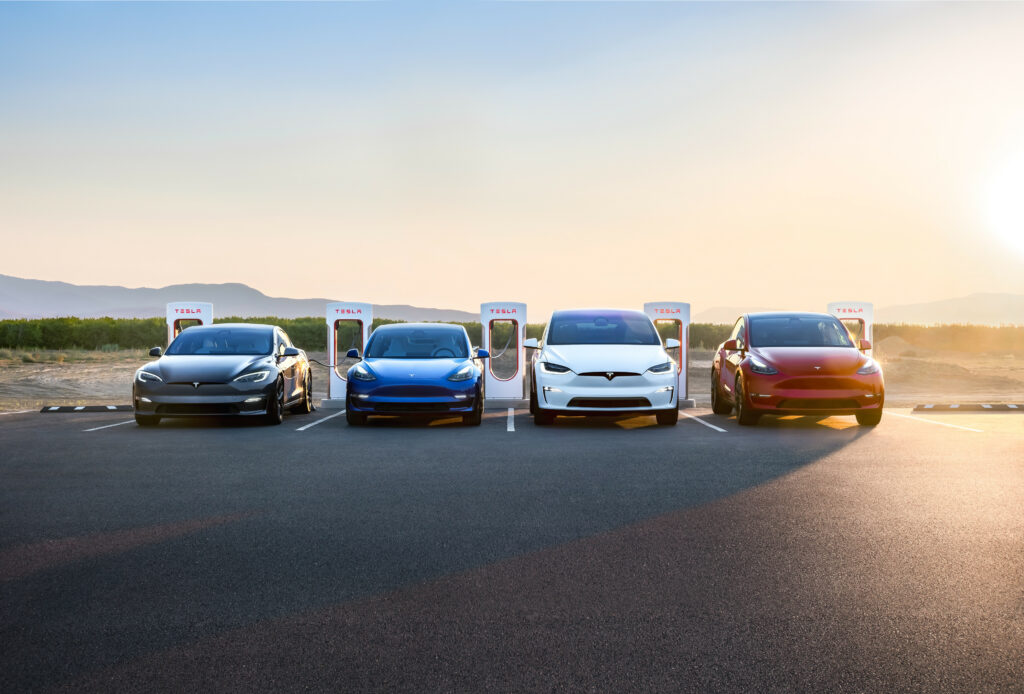
But wait, there’s more! Engineers rate the levels of automation based on how independently the system can perform tasks, and how much human input and supervision is required. Here are the basics of the five levels of automation, according to the Society of Automotive Engineers.
Now that we’ve covered the engineering and industry jargon, let’s revisit our definition.
What exactly is self-driving technology? The most agreeable definition is that self-driving cars fall within level 3 or level 4 automation, in which the vehicle can perform most driving tasks in a geofenced area, but with constant human monitoring and intervention when needed. Fully autonomous vehicles fall within the ultimate frontier of automotive engineering, Level 5. A true autonomous vehicle can operate from start to finish without driver input or attention. Imagine reading a book or taking a nap on your way to work.
No cars on today’s roads are capable of fully autonomous driving. Automated driving remains years away, however tremendous resources are committed to the cause of unraveling the ultimate challenge in automotive engineering. Tesla’s Autopilot and Full Self-Driving features are branded as Level 2 systems, which means that constant supervision is required, and intervention is to be expected. This discrepancy between the Level 2 classification of Tesla’s driver assistance systems and the names of the products remains the source of much controversy among engineers and driver safety advocates alike. Can’t we all agree that honest advertising is always in the interest of safety and responsibility?
Aside from automakers, there are dozens of other companies innovating in the autonomous driving space. Waymo, Argo AI and Cruise are all putting geofenced autonomous cars on the road today for real-world testing and limited customer use for ride-hailing. What is a self-driving car in 2022? It’s likely a prototype with limited use.
Tesla is the clear leader in advanced driver assistance systems. However, the extent of Tesla’s lead among industry competitors is not nearly as clear as it was a few years ago. Tesla has taken a bold step away from using radar for sensory inputs. The decision to remove LiDAR from new Tesla models starting in 2020 was so controversial that some senior engineers quit in protest.
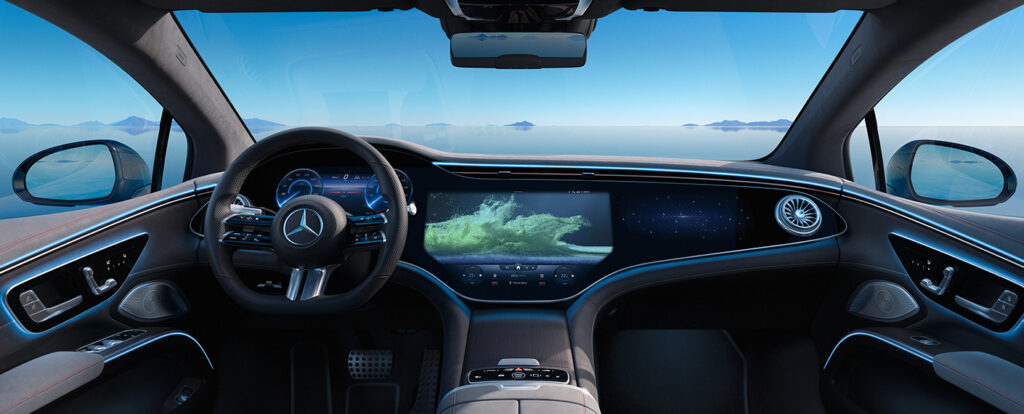
Remarkably, Tesla is no longer the only automaker breaking autonomy barriers. In 2021, Mercedes-Benz became the very first automaker to get regulatory approval for Level 3 autonomous driving on limited public roads. For now, Mercedes Drive Pilot is available on 8,197 miles of German highways at speeds up to 37 miles per hour. What makes Mercedes Drive Pilot so special is that it is the first approved consumer-ready system to permit the driver to take their attention away from the road while the vehicle is in motion. Even Tesla’s Full Self-Driving feature does not permit the driver to direct their attention elsewhere, despite evidence of the contrary on social media.
For the foreseeable future, American roads will see even more Level 2 driver assistance systems calculating their way through traffic as nearly every automaker in the market steps up their autonomy game. Level 3 remains in development, even for Tesla. Mercedes has not announced if it will seek approval in the US anytime soon, likely due to the murky regulatory environment.
Fully automated driving is likely in our future, but no one knows when it will be safe and accessible to all. The pace of innovation ebbs and flows. Engineers, regulatory agencies and insurance companies have some hard problems to solve. For now, proceed with caution when at the wheel of a “self-driving” vehicle. Their arrival is a great reason to look twice when crossing the street. You never know who (or what) might be coming around the corner.
CarEdge Just Launched a New Search Engine to Make Buying Your Next Car Easier!
We have thousands of vehicles listed today. Each listing includes industry insights, empowering data and the true TotalPrice that will make buying a car the transparent process it should’ve always been. We show you what dealers don’t want you to know. We believe that data can be your superpower when buying a car. Check it out here!

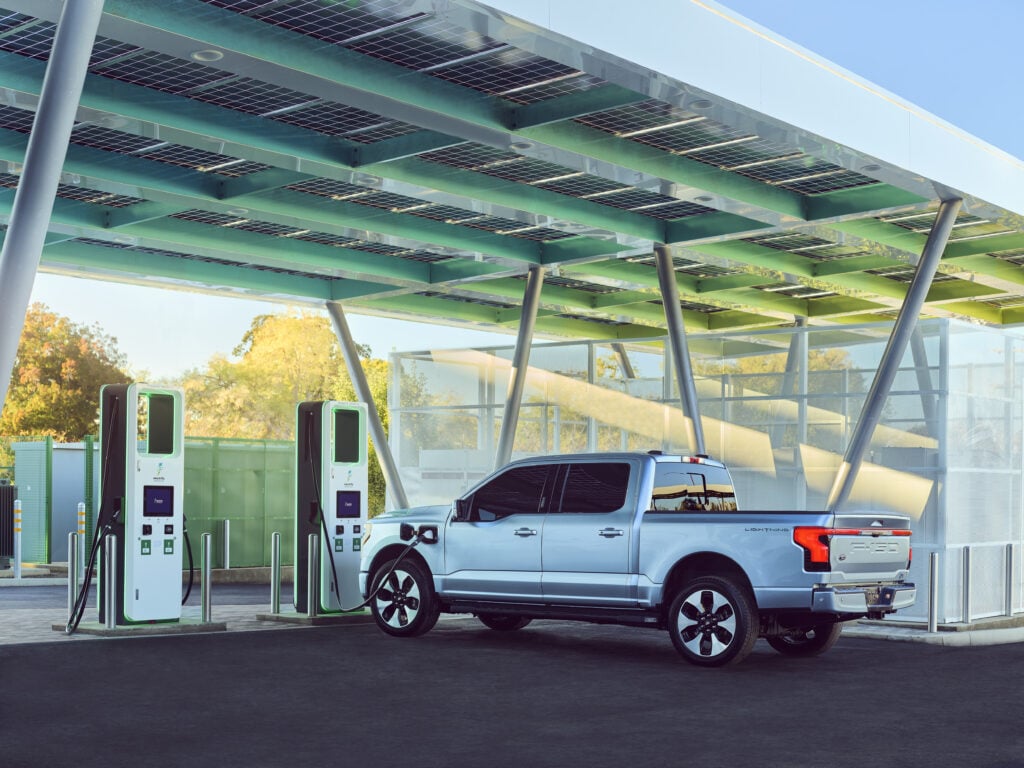
Update: Every day that we wake up to higher gas prices, the case gets stronger for EV adoption. If only EV prices weren’t sky-high. With gas at $4.50, the average American driver commuting 15,000 miles per year can easily save $150 per month or more by going electric. Check out the details below.
Charging an electric vehicle is a whole new experience, one that brings advantages and disadvantages for drivers. If you’ve been stopping at gas stations for decades, the thought of plugging in and waiting for your car to charge may be a bit too much to swallow. But over 80% of EV charging is done at home, where the cost savings are greatest. Two out of three American drivers are considering going electric for their next vehicle, and billions of dollars are being funneled into EV development and infrastructure.
EVs have a higher upfront cost than combustion vehicles, so it’s important to find ways of making up for the expense with fuel savings. Unfortunately, not all charging options are affordable. Here’s how you can save money when charging your EV in 2022.
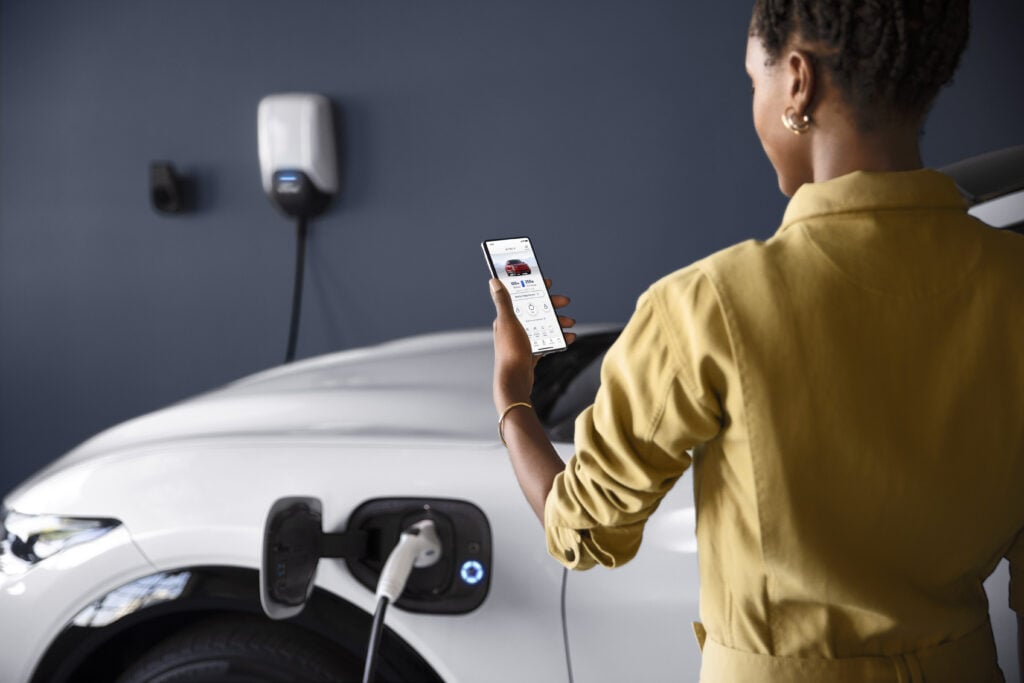
When do you usually charge your phone? While you sleep at home? Oddly enough, for most drivers, that’s exactly how their EVs are charged! Data from the US Department of Energy shows that the vast majority of electric vehicle charging is done at home. Whether you plug in to a simple 120 volt outlet in your driveway or have a more powerful 240 volt outlet in your garage, charging at home is usually the most affordable way to power up.
In the US, the average residential electricity rate is $0.14 per kilowatt-hour, however rates vary widely from one state to another. In Hawaii, the average rate is a whopping $0.34 per kWh, while it’s between $0.10 and $0.14 per kWh in more affordable energy states like Washington and Texas.
What does that all mean? Say you have a level 2 charger capable of filling up your battery from empty in about 7 hours. Plug in every evening, and wake up with a full battery every morning. What did that full ‘tank’ of electrons cost? Let’s consider a real-world example. The 2022 Tesla Model 3 has a 82 kWh battery, so at average American residential rates, at home charging a Tesla Model 3 at home costs just $11.48 for a full charge. That’s enough electrons for 358 miles of driving.
What about if the same Model 3 owner lived in California instead? At typical California residential electricity rates, the same charge would cost $18.04. Considering that a tank of gas costs over $75 today, the savings add up. But clearly, it depends on the rates you pay for power and miles driven per year to maximize savings. If you’d like to know more about average residential electricity rates in each state, you can find that information here.
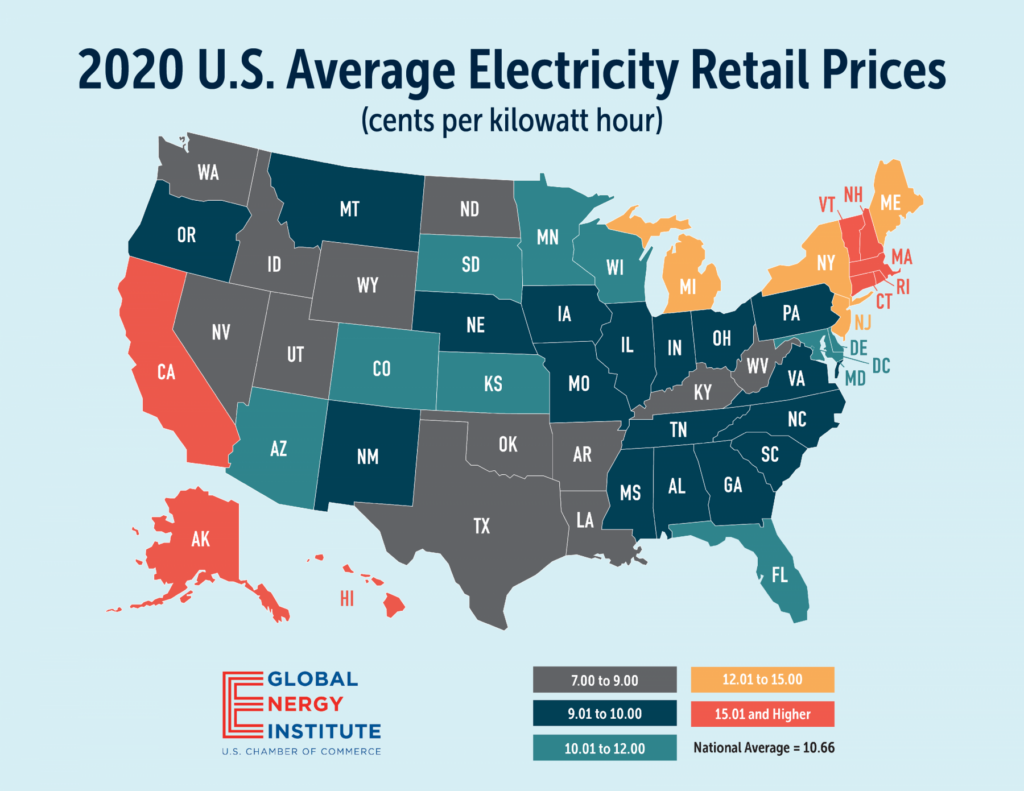
Here’s how much EV drivers from each state can expect to pay for a full charge. The examples below specifically reflect an EV with an 82 kWh battery, such as a Tesla Model 3 or Model Y. My own Hyundai IONIQ 5 has a 72.5 kWh battery.
The stark difference between home charging and public fast charging highlights the fact that going electric likely only brings savings when most charging is done at home.
| State | Residential Electricity Rate ($ per kWh) | Cost of Charging to 100% at Home (82 kWh battery) | EV Fuel Savings Compared to Filling an 18 Gallon Tank at $4.50/Gal | Annual Savings: 15,000 miles/year, 25 MPG versus 300 miles on a charge |
|---|---|---|---|---|
| Alabama | $0.14 | $11.48 | $69.52 | $2,126 |
| Alaska | $0.23 | $18.86 | $62.14 | $1,757 |
| Arizona | $0.13 | $10.66 | $70.34 | $2,167 |
| Arkansas | $0.11 | $9.02 | $71.98 | $2,249 |
| California | $0.22 | $18.04 | $62.96 | $1,798 |
| Colorado | $0.14 | $11.48 | $69.52 | $2,126 |
| Connecticut | $0.23 | $18.86 | $62.14 | $1,757 |
| Delaware | $0.14 | $11.48 | $69.52 | $2,126 |
| DC | $0.14 | $11.48 | $69.52 | $2,126 |
| Florida | $0.12 | $9.84 | $71.16 | $2,208 |
| Georgia | $0.13 | $10.66 | $70.34 | $2,167 |
| Hawaii | $0.34 | $27.88 | $53.12 | $1,306 |
| Idaho | $0.11 | $9.02 | $71.98 | $2,249 |
| Illinois | $0.14 | $11.48 | $69.52 | $2,126 |
| Indiana | $0.14 | $11.48 | $69.52 | $2,126 |
| Iowa | $0.13 | $10.66 | $70.34 | $2,167 |
| Kansas | $0.13 | $10.66 | $70.34 | $2,167 |
| Kentucky | $0.12 | $9.84 | $71.16 | $2,208 |
| Louisiana | $0.12 | $9.84 | $71.16 | $2,208 |
| Maine | $0.18 | $14.76 | $66.24 | $1,962 |
| Maryland | $0.14 | $11.48 | $69.52 | $2,126 |
| Massachusetts | $0.23 | $18.86 | $62.14 | $1,757 |
| Michigan | $0.18 | $14.76 | $66.24 | $1,962 |
| Minnesota | $0.14 | $11.48 | $69.52 | $2,126 |
| Mississippi | $0.12 | $9.84 | $71.16 | $2,208 |
| Missouri | $0.11 | $9.02 | $71.98 | $2,249 |
| Montana | $0.12 | $9.84 | $71.16 | $2,208 |
| Nebraska | $0.11 | $9.02 | $71.98 | $2,249 |
| Nevada | $0.13 | $10.66 | $70.34 | $2,167 |
| New Hampshire | $0.21 | $17.22 | $63.78 | $1,839 |
| New Jersey | $0.16 | $13.12 | $67.88 | $2,044 |
| New Mexico | $0.14 | $11.48 | $69.52 | $2,126 |
| New York | $0.21 | $17.22 | $63.78 | $1,839 |
| North Carolina | $0.12 | $9.84 | $71.16 | $2,208 |
| North Dakota | $0.12 | $9.84 | $71.16 | $2,208 |
| Ohio | $0.13 | $10.66 | $70.34 | $2,167 |
| Oklahoma | $0.13 | $10.66 | $70.34 | $2,167 |
| Oregon | $0.12 | $9.84 | $71.16 | $2,208 |
| Pennsylvania | $0.15 | $12.30 | $68.70 | $2,085 |
| Rhode Island | $0.22 | $18.04 | $62.96 | $1,798 |
| South Carolina | $0.14 | $11.48 | $69.52 | $2,126 |
| South Dakota | $0.13 | $10.66 | $70.34 | $2,167 |
| Tennessee | $0.12 | $9.84 | $71.16 | $2,208 |
| Texas | $0.13 | $10.66 | $70.34 | $2,167 |
| Utah | $0.11 | $9.02 | $71.98 | $2,249 |
| Vermont | $0.21 | $17.22 | $63.78 | $1,839 |
| Virginia | $0.13 | $10.66 | $70.34 | $2,167 |
| Washington | $0.11 | $9.02 | $71.98 | $2,249 |
| West Virginia | $0.14 | $11.48 | $69.52 | $2,126 |
| Wisconsin | $0.15 | $12.30 | $68.70 | $2,085 |
| Wyoming | $0.12 | $9.84 | $71.16 | $2,208 |
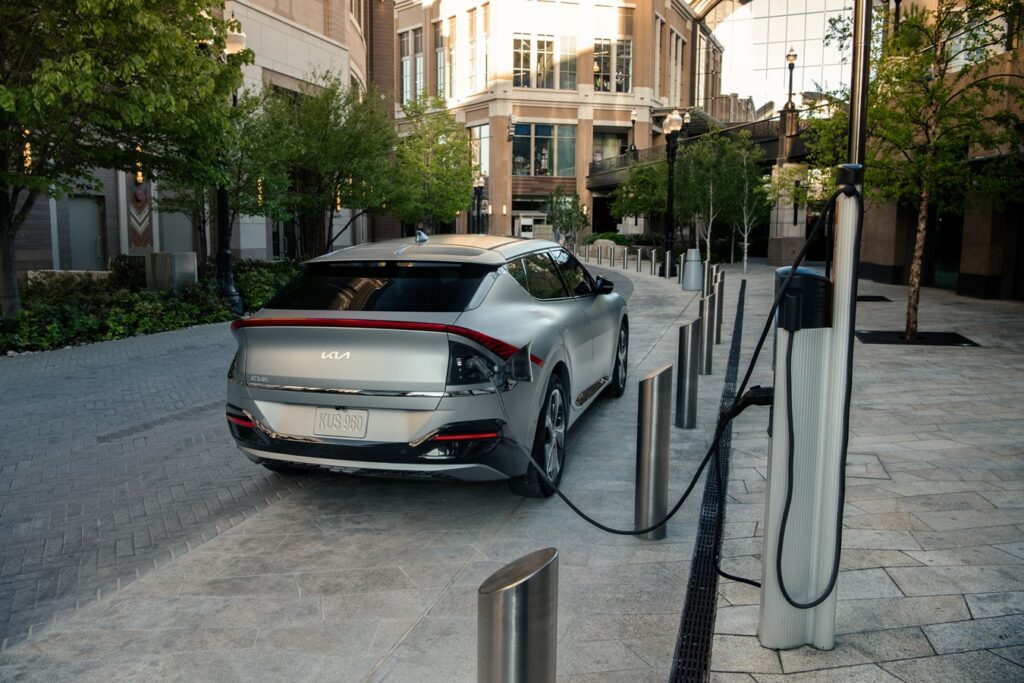
If you already have a 240 volt dryer outlet within reach, you’re all set for just about any scenario. If you don’t, you’re left with two options. If you drive less than 40 miles on most days and live within a reasonable distance of a public charger (in case you need it), you will save the most money by using the so-called ‘trickle charge’ supplied by the charger included with the car. You simply plug into a standard three-prong 120 volt wall outlet. This is called level 1 charging.
Depending on the vehicle, trickle charging typically adds 3-4 miles of charge per hour to the battery, or about 40 miles per night if you leave your car plugged in. So, how much does it cost to charge an electric car? If the above scenario describes your driving habits, you’ll just pay the same residential electricity rates that your pay to power your home.
If that’s not quite enough recharge for your daily needs, you’ll either need to make weekly visits to public fast chargers, or spend anywhere from $800 – $2000 on installation of a level 2 charger. Level 2 chargers supply more power in less time. They plug into a 240 volt outlet, the exact same kind that is used for dryers, ovens and other large appliances at home.
If you already have a conveniently located dryer outlet within reach of where you park the car, you can purchase a power splitter for as little as $300. Splitters send charge to the home appliance (such as a dryer) when needed, and then divert power to charging the car when the appliance is not in use. This saves A LOT of money versus getting electrical work done!
In summary, if you drive less than 40 miles a day, it usually makes the most sense to avoid the costly level 2 charger and stick with a regular wall outlet. If you drive significantly more, consider installing a level 2 charger or simply topping off your battery once or twice a week at a local public fast charger to avoid the expense of electrical work.
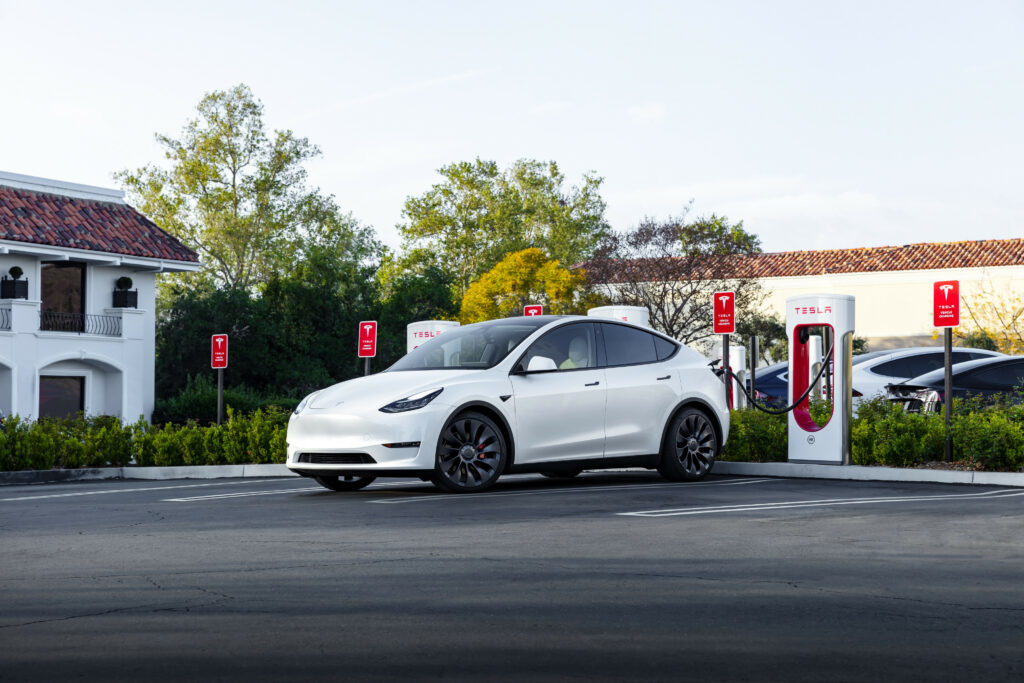
First, there’s one thing we need to make clear. Electric vehicles are not meant to be charged at public DC (direct current) fast chargers every time a charge is needed. It stresses the battery, and it costs a lot more than charging at home. For instance, fast chargers can charge a Model 3 from 10-80% in less than 20 minutes. That much energy transfer puts wear on the vehicle’s battery management system. Fast charging is great for road trips or when you’re in a pinch, but that’s all they’re meant for.
How much can you expect to pay for charging at a public DC fast charging station? Let’s consider the two largest charging networks in the nation: Tesla Superchargers and Electrify America.
As of early 2022, most Tesla Superchargers charge $0.28 per kWh of electricity. For a 2022 Tesla Model Y with a 82 kWh battery pack, that adds up to a cost of $22.96 to go 330 miles on a charge. Some Superchargers have variable pricing dependent on demand charges, as noted on Tesla’s Supercharging support page. “Certain Supercharger stations offer on-peak and off-peak rates. The rates and peak times are both displayed in the navigation application on the touchscreen.”
Depending on state and local regulations, some Tesla Superchargers charge per minute, rather than per kilowatt-hour of electricity. Tesla recently updated the rate structure for their per-minute Superchargers. With Tesla’s plug-and-charge, customers simply plug in the vehicle and the charger communicates with the car, begins charging and bills the customer’s Tesla account.
Here’s how the updated rate structure is tiered in 2022:
Source: Tesla
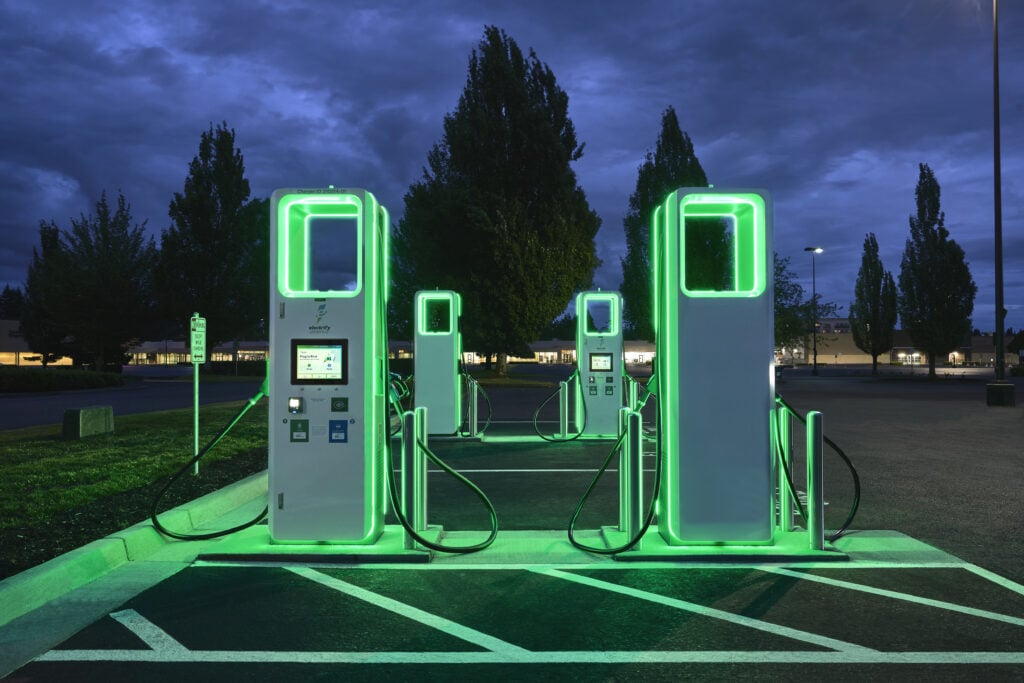
Over at Electrify America, customers can either pay $0.43 per kWh of electricity, or become a Pass+ member for just $4/month and charge at $0.31 per kWh. Having such an affordable membership plan is an interesting approach. That is to say, it almost seems like Electrify America is aiming to become a subscription that everyone with an EV will buy into for a sense of range security, even if they rarely use the network. Down the road, I’m sure prices will go up.
For a Ford Mustang Mach-E, filling up the 98 kWh battery from empty will cost $30.38 with the Pass+ membership. However, the cost jumps to $42.14 without it. Clearly, the fuel savings we often associate with going electric evaporate if charging costs are too high.
| Cost of Charging to 100% at a Tesla Supercharger | Cost of Charging to 100% at Electrify America as a Member | Cost of Charging to 100% at Electrify America as a Guest | Cost of Filling up an 18 Gallon Tank of Gas at $3.25/Gallon |
| $22.96 | $25.42 | $35.26 | $58.50 |
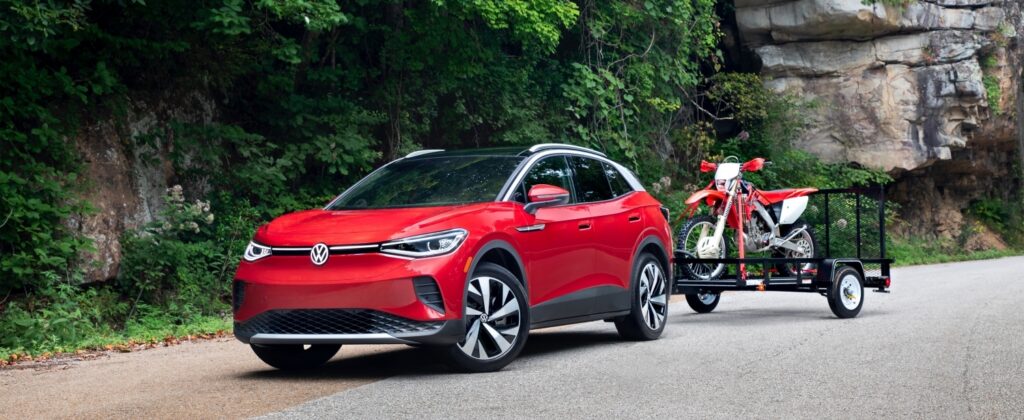
If you know someone who pulls up to Tesla Superchargers in their 2014 Model S and leaves without paying a dime, don’t expect the same perks when shopping for a 2022 Tesla. Early adopters received free supercharging ‘for life’, and there are plenty of Tesla owners out there who keep driving their high-mileage, slow-charging old Model S just for the free charging incentive.
If you’re hoping to score free charging with any of the 2022 EV models, I’ve got good news for you. Many 2022 models come with free charging at Electrify America charging stations. These new EVs all come with a free charging incentive for a limited time:
Some employers, especially large corporations and tech companies, offer free charging for EVs at dedicated parking spots. However, if your employer doesn’t offer charging, maybe you can be the one to spark the idea and help make it happen.
Prices have plummeted in recent years, and having an EV is yet another incentive to go solar. Most utility customers can participate in a net metering program that compensates homeowners for unused solar electricity contributed to the grid. If the sun is shining bright while you’re away at work, you still receive bill credits for the unused power your panels generated. The utility bill credits you’ll receive may cover the entire cost of charging your car. That’s 100% clean, free power for both your home and transportation!
How much does it cost to charge an electric car? As you can see, it depends on utility rates, incentives and if you charge at home or at public fast chargers. Fuel savings is one of the greatest benefits of switching from a combustion vehicle to an electric vehicle. As your consumer advocate, we want to make it clear that EVs don’t always save money. However, for the vast majority of American drivers, affordable electricity rates mean that at least $1,000 could be saved each year by going electric. And that doesn’t include the lower maintenance costs that most EVs have. For those who are fortunate to have a place to plug in at home or work, switching to an electric vehicle is a no-brainer.
Have any questions or comments? How are you feeling about the electrification of the auto industry? Let us know in the comments below, or check out the CarEdge Community forum at caredge.kinsta.cloud. You can also reach out to me at [email protected].